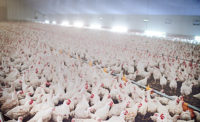Evaluating the Effects of Variable Light Intensity Programs on Broiler Welfare

Light intensity has been shown to affect the activity of birds, but most studies have focused on constant light intensities to determine their effect on welfare. Light intensity preference behavior of birds has been suggested to be an additional component of bird welfare.
Animal welfare research, conducted at the University of Arkansas (UARK), is on target to help determine optimum lighting programs and enrichment treatments for the lameness of broilers. Principal investigator Dr. David Caldwell and his research team received funding in spring 2020 through the USPOULTRY Board Research Initiative program to determine the effects of variable intensity lighting and natural lighting programs on behavior, gait score, and stress hormone (corticosterone) compared with constant light intensity programs in commercial broiler farms. Other objectives in the study include investigating the effect of enrichment huts on broiler behavior, gait score, and stress in the different lighting programs. Lastly, researchers are studying central positive welfare indicators as they are affected by various light intensities, natural lighting programs, and enrichment hut treatments.
Aspects of the study are being carried out within the UARK Department of Poultry Science and at the Tyson Foods’ Broiler Welfare Research Farm. Four commercial broiler houses have been used for evaluating the effects of different constant light intensities (5 lux, 20 lux), natural light (480 lux), and variable light intensity on the performance and welfare of birds. The variable intensity light house was about 40 lux light intensity over the feed lines and dimmer light intensity (2-5 lux) at the sidewalls. Investigators observed the increase of broilers dust-bathing behavior and better performance in the variable intensity light house, suggesting a beneficial effect on broilers natural exercise motivation by the variable intensity lighting program in the commercial broiler houses. The enrichment huts provide birds a lower light intensity environment inside and additional area to rest with easy access. Investigators are testing the synergistic effect of the enrichment huts on the variable intensity lighting program. The study of central positive welfare indicators and stress hormone are going on to better explain the observed performance and welfare benefits of the variable intensity lighting program.
Findings from this study are expected to be completed over the next year. Results should provide the broiler industry valuable new information on how to improve animal welfare. The variable light intensities and enrichment huts are expected to stimulate volunteer walking behavior for consuming feed/water and taking rest time, as well as improve welfare and gait score in the commercial broiler farm.
Looking for a reprint of this article?
From high-res PDFs to custom plaques, order your copy today!








